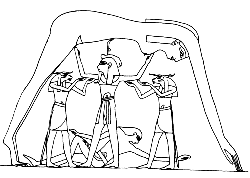
Goddess of the sky, visualized as bending over the earth with her hands and feet at the corners of the earth and her head in the west. The sun travelled along her body every day towards the west, and once it got there it was swallowed by Nut. During the night it travelled through her body until she gave birth to it again in the east the next morning. This cycle is depicted on the ceilings of the tombs in the Valley of the Kings in particular, but also appears in temples. The Egyptians hoped to be born again every day after death, just like the sun, and to live among the stars. Thus Nut became a funerary goddess, stretching protectively over the deceased, and through whom the deceased could rise again. From an early period the sarcophagus and tomb were identified with Nut. Even in the Old Kingdom the ceiling of the burial chamber was decorated with stars, or the sarcophagus called 'mother'. Many coffins from later periods have a depiction of Nut on the inside of their lids - she is literally stretching herself out above the deceased. In addition to the notions of rebirth and protection, Nut is also depicted giving the deceased food and water and cool air. These images indicate a connection between Nut and Hathor, the protectress of the dead. Like the latter, Nut could be portrayed as a tree goddess giving the deceased water. In the Ennead of Heliopolis, Nut is the wife of the earth god Geb, her brother. She is separated from him by their father Shu, the god of the air. Nut was the mother of Osiris, Isis, Nephthys and Seth; sometimes Horus is also called her son. Plutarch relates that the sun god Helios (the Greek equivalent of Re) put a curse on Rhea (Nut), forbidding her to give birth on any day of the calendar year. Thanks to intervention by Hermes (Thoth), five epagomenal days were added to the year, on which Nut gave birth to her five children, including Apollo (Horus). Nut is usually depicted as a woman, sometimes with the hieroglyphs for her name on her head. She is often bending over the earth with stars depicted on her body. Occasionally she has wings as a sign of the coolness and protection she gives. She is also shown in the form of a cow.